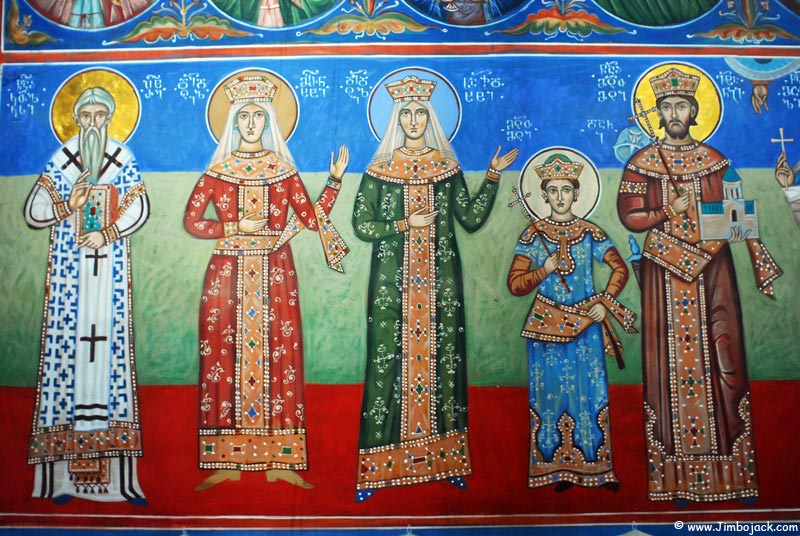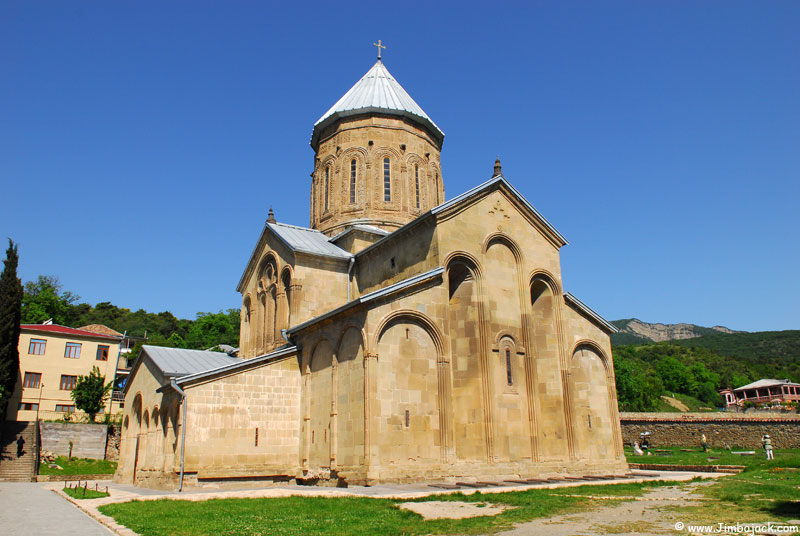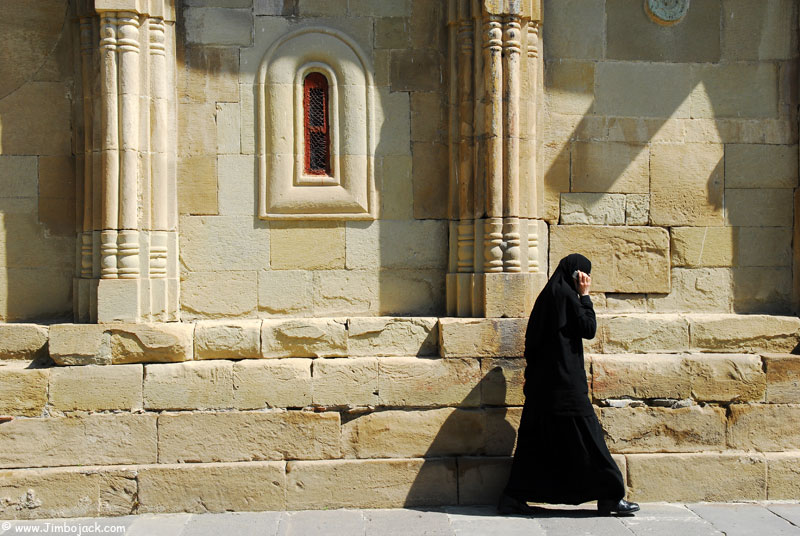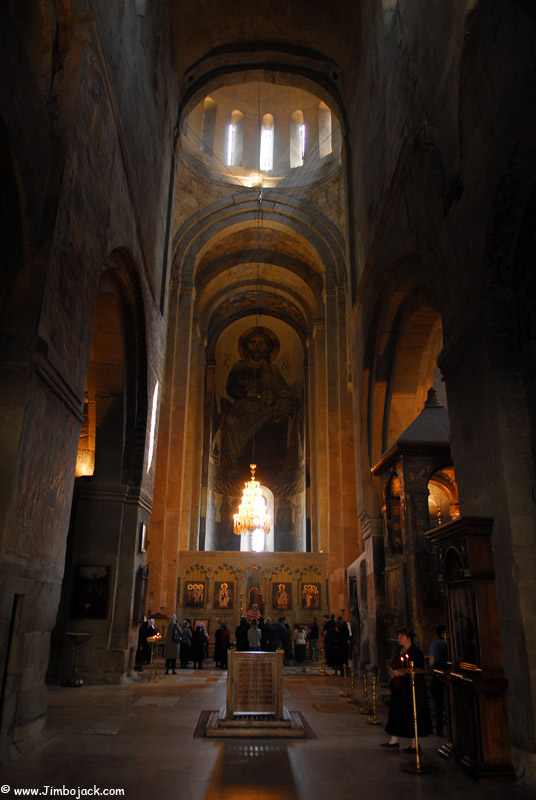Georgia - Tbilisi and Mtskheta
So I decided to post some more photos from Georgia, I'm sure everyone knows about the trouble there right now
Various pictures from Tbilisi, the Georgian capital
Kashveti Church. According to legend, the Syrian father Davit Garejeli was accused by a nun of impregnating her. He replied that if that was true, she would give birth to a baby, but if she was lying she would give birth to a stone. She gave birth to a stone, thus giving the name to the church (Kashveti means "Stone Birth")


Various street photos



I came upon a small church on the path leading up to Kartlis Deda (Mother Georgia) statue. The church was locked as I passed by it, but a man was working outside. I started talking to him and it turned out he was an artist, and it was his job to repaint the inside of the church. Basili (his name) opened the church for me and showed me how he worked. It turned out he was actually a sculptor (with a fairly negative opinion of the artist who designed the Kartlis Deda statue), but was doing the restoration/painting work at this church at the moment. While we were talking his friend came by and they invited me to drink some wine with them. We went to a small room next to the church and ended up talking for a couple of hours about Georgian culture, religion and politics. All of the things you never talk to strangers about...
The inside of the church, painted by Basili Zandukeli. This is his completed work..


Work in progress


The 2 liter cola bottle actually has wine (we drank most of it). While drinking, we ate a loaf of bread with salt (the traditional way)

Somewhat buzzed from the wine, I continued going up to the Kartlis Deda statue. Here is a view of Tbilisi from the trail

Kartlis Deda (Mother Georgia) statue. A 20 meter tall aluminum woman, the statue was created in the early 1960's and is a metaphor for the Georgian character. Holding a cup of wine and a sword, it warmly welcomes guess and fiercely fights off enemies.

Another view of Tbilisi

Tsminda Sameba (Holy Trinity) Cathedral. The biggest cathedral in the Caucasus, it is somewhat controversial as it was built upon an old Armenian cemetery.








Mtskheta
Mtskheta is the spiritual heart of Georgia. Located at the confluence of the Mtkvari and Aragvi rivers, it was here that Christianity was adopted as a state religion in 337 (Georgia was the second country to adopt Christianity as a state religion, 36 years after Armenia). Some of the oldest and most important churches in Georgia are located here.
The old Mtskheta museum building, it was recently relocated

Samtavro church, built in the 1130's it was the former residence of the lords of Mtskheta, now it is used as a nunnery.



Sveti-Tskhoveli Cathedra, built in the 11th century. According to tradition, Christ's robe was buried here. Elioz, a Georgian Jew, was in Jerusalem during the time of the crucifixion and brought the robe back to Mtskheta. His sister Sedonia received the robe from him and immediately died in a passion of faith. Nobody was able to take the robe away from her hands, so they were buried together and a tree grew on their grave. While building the first church at this location, the builders cut through the trunk of the tree but it did not fall. St. Nino came to pray at the site and as a result the tree became whole again, blossomed and started producing healing oil. The church received the name Sveti-Tskhoveli, meaning "life-giving column".
The first church here was built in the 4th century, it was replaced in the 6th century by a stone structure built by King Vakhtang Gorgasali. The building standing today was constructed between 1010 and 1029 on the orders of patriarch Melkhisedek. It was damaged in the 14th century by the forces of Tamerlane and restored in the 15th. The defensive wall around the site was added in the 18th century.






I hope you enjoy these photos, I'll post a series from Azerbaijan next.
Here is my page with more photos from Georgia:
http://www.jimbojack.com/Caucasus_&_Europe.htm
Various pictures from Tbilisi, the Georgian capital
Kashveti Church. According to legend, the Syrian father Davit Garejeli was accused by a nun of impregnating her. He replied that if that was true, she would give birth to a baby, but if she was lying she would give birth to a stone. She gave birth to a stone, thus giving the name to the church (Kashveti means "Stone Birth")


Various street photos



I came upon a small church on the path leading up to Kartlis Deda (Mother Georgia) statue. The church was locked as I passed by it, but a man was working outside. I started talking to him and it turned out he was an artist, and it was his job to repaint the inside of the church. Basili (his name) opened the church for me and showed me how he worked. It turned out he was actually a sculptor (with a fairly negative opinion of the artist who designed the Kartlis Deda statue), but was doing the restoration/painting work at this church at the moment. While we were talking his friend came by and they invited me to drink some wine with them. We went to a small room next to the church and ended up talking for a couple of hours about Georgian culture, religion and politics. All of the things you never talk to strangers about...
The inside of the church, painted by Basili Zandukeli. This is his completed work..


Work in progress


The 2 liter cola bottle actually has wine (we drank most of it). While drinking, we ate a loaf of bread with salt (the traditional way)

Somewhat buzzed from the wine, I continued going up to the Kartlis Deda statue. Here is a view of Tbilisi from the trail

Kartlis Deda (Mother Georgia) statue. A 20 meter tall aluminum woman, the statue was created in the early 1960's and is a metaphor for the Georgian character. Holding a cup of wine and a sword, it warmly welcomes guess and fiercely fights off enemies.

Another view of Tbilisi

Tsminda Sameba (Holy Trinity) Cathedral. The biggest cathedral in the Caucasus, it is somewhat controversial as it was built upon an old Armenian cemetery.








Mtskheta
Mtskheta is the spiritual heart of Georgia. Located at the confluence of the Mtkvari and Aragvi rivers, it was here that Christianity was adopted as a state religion in 337 (Georgia was the second country to adopt Christianity as a state religion, 36 years after Armenia). Some of the oldest and most important churches in Georgia are located here.
The old Mtskheta museum building, it was recently relocated

Samtavro church, built in the 1130's it was the former residence of the lords of Mtskheta, now it is used as a nunnery.



Sveti-Tskhoveli Cathedra, built in the 11th century. According to tradition, Christ's robe was buried here. Elioz, a Georgian Jew, was in Jerusalem during the time of the crucifixion and brought the robe back to Mtskheta. His sister Sedonia received the robe from him and immediately died in a passion of faith. Nobody was able to take the robe away from her hands, so they were buried together and a tree grew on their grave. While building the first church at this location, the builders cut through the trunk of the tree but it did not fall. St. Nino came to pray at the site and as a result the tree became whole again, blossomed and started producing healing oil. The church received the name Sveti-Tskhoveli, meaning "life-giving column".
The first church here was built in the 4th century, it was replaced in the 6th century by a stone structure built by King Vakhtang Gorgasali. The building standing today was constructed between 1010 and 1029 on the orders of patriarch Melkhisedek. It was damaged in the 14th century by the forces of Tamerlane and restored in the 15th. The defensive wall around the site was added in the 18th century.






I hope you enjoy these photos, I'll post a series from Azerbaijan next.
Here is my page with more photos from Georgia:
http://www.jimbojack.com/Caucasus_&_Europe.htm
Phillip
Just back from Europe, Eastern Turkey, Iraq and Iran, new photos coming soon!
Over 100 Countries, thousands of pictures, one Website (being redesigned at the moment)
www.Jimbojack.com
Just back from Europe, Eastern Turkey, Iraq and Iran, new photos coming soon!
Over 100 Countries, thousands of pictures, one Website (being redesigned at the moment)
www.Jimbojack.com
0
Comments
Bread and salt? NEver tried that before!
www.tednghiem.com
Yes, I was there around the end of May.
Eating bread with salt is an old slavic tradition, you'll see it in Poland, Ukraine, Slovakia, etc. I was a little bit surprised to see it in Georgia
Just back from Europe, Eastern Turkey, Iraq and Iran, new photos coming soon!
Over 100 Countries, thousands of pictures, one Website (being redesigned at the moment)
www.Jimbojack.com
http://www.moose135photography.com
E
My site | Non-MHD Landscapes |Google+ | Twitter | Facebook | Smugmug photos
Most bread has salt added to it when mixed before baking. Without salt, bread tastes real flat. My wife is a serious baker, that is how I came to know this.
Very interesting travelogue.
Moderator of the Technique Forum and Finishing School on Dgrin
Another really nice series.
I spent time in Czech Republic and no one tried to get me to eat bread and salt
I have a friend whose father owns 4 theaters in Tbilisi .....I really want to see that country.
Thanx for sharing your trip with us!!
My Gallery
AndyW
so, there is a war? to bad indeed.
a peacefully place ...otherwhite.
Help Desk Solution
http://www.germaine.smugmug.com
Hi. I stumbled upon your wonderful pictures while writing an article about my recent visit to Tbilisi. I was there in July 2008 just for a few days - how things change in only a few weeks. I will post some of my pictures when I work out how to do it! Loved the shots of the interior of the churches; I didn't have the courage to take any myself but was blown away by the incredible art and beautiful golds.